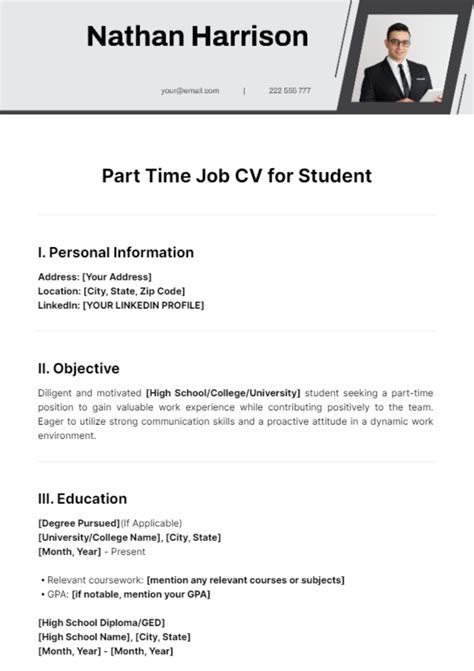As a student juggling academic pursuits and financial responsibilities, a part-time job can be a lifesaver. However, landing that coveted job requires a well-crafted CV that showcases your skills, experience, and suitability for the role. This comprehensive guide will empower you to create a student CV that will grab the attention of potential employers.

Highlight Your Skills and Abilities
According to a survey by LinkedIn, nearly 90% of employers value soft skills over technical skills for entry-level positions. Identify and emphasize transferable skills that are relevant to the job, such as:
- Communication
- Teamwork
- Problem-solving
- Time management
- Customer service
Example:
Strong interpersonal and communication skills honed through leadership roles in student clubs.
Quantify Your Experience
Employers are drawn to candidates who can demonstrate quantifiable results. Use numbers to highlight your achievements in previous work, volunteer, or extracurricular experiences.
Example:
Increased sales by 15% through innovative promotional strategies during a summer internship at a local retail store.
Tailor Your CV to the Job
Research the job description thoroughly and identify the keywords that reflect the required skills and qualifications. Mirror these keywords in your CV by using similar language and highlighting relevant experiences.
Example:
Proven ability to manage multiple projects simultaneously, prioritize tasks, and meet deadlines, as demonstrated in the role of Event Coordinator for the university’s annual student festival.
Use a Professional Template and Design
Choose a template that is clean, easy to read, and visually appealing. Use a professional font, such as Calibri, Arial, or Times New Roman. Avoid using bright colors or excessive graphics.
Proofread Carefully
Before submitting your CV, proofread it thoroughly for any errors in spelling, grammar, or formatting. Ask a friend, family member, or career counselor to review it for an objective perspective.
Additional Tips for Student CVs
- Keep it concise: Aim for a one-page CV that highlights your most relevant skills and experience.
- Use specific examples: Instead of simply stating that you have leadership skills, provide specific instances where you demonstrated those skills.
- Quantify your impact: Use numbers to show how your actions made a difference in previous roles.
- Tailor your CV: Customize your CV for each job you apply for, highlighting the skills and experience that are most relevant to the position.
- Include a cover letter: A well-written cover letter can complement your CV and provide additional context for your application.
Effective Strategies for Landing a Part-Time Job
1. Network: Attend career fairs, join student clubs, and reach out to potential employers through LinkedIn.
2. Leverage social media: Maintain a professional online presence on platforms such as LinkedIn and Twitter.
3. Seek on-campus resources: Many universities offer career services, job boards, and resume review sessions.
4. Apply strategically: Take the time to research potential employers and tailor your CV and cover letter to each specific job you apply for.
Frequently Asked Questions
Q1: How do I format my CV?
* Use a professional font in size 11-12 pt.
* Include your name, contact information, and a brief summary at the top.
* List your education, skills, and experience in reverse chronological order.
Q2: What if I have limited work experience?
* Highlight relevant skills and experience gained through volunteer work, extracurricular activities, or projects.
* Use specific examples to demonstrate your abilities.
Q3: How long should my CV be?
* Aim for a one-page CV for entry-level positions.
* If you have extensive experience, you may consider a two-page CV.
Q4: What should I exclude from my CV?
* Personal information (e.g., age, gender, marital status)
* Irrelevant experience
* Excessive detail or jargon
* Typos or grammatical errors
Q5: How do I optimize my CV for Applicant Tracking Systems (ATS)?
* Use keywords from the job description.
* Save your CV in PDF format.
* Use a simple and ATS-friendly font.
Q6: Is it okay to use a template?
* Yes, using a professional template can help your CV look polished and consistent.
* Avoid using overly creative or distracting templates.
